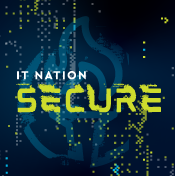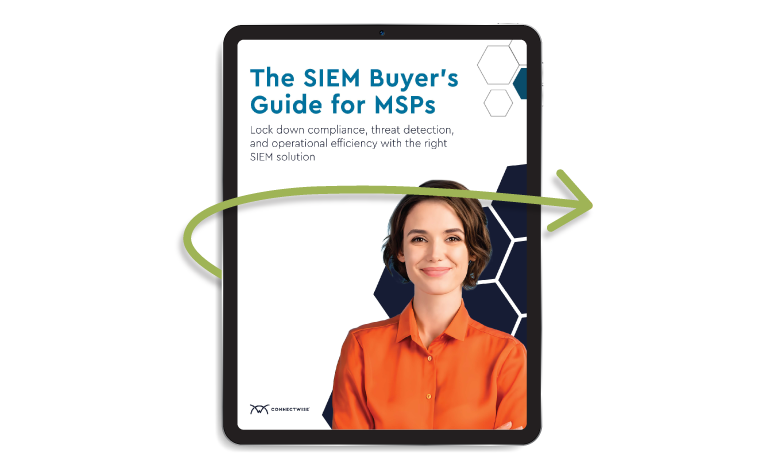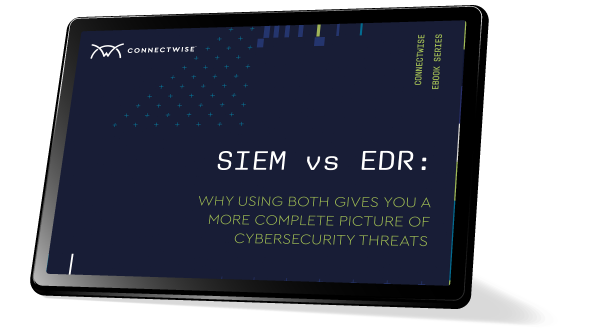1.3 Million
Events reviewed per second
100,000+
SMBs actively protected
6 million
Attacks prevented in 2024
Benefits
See how SIEM can help your business
Combine robust threat intelligence, automated compliance and seamless integrations to improve visibility, detection speed, and accuracy with fewer false positives.
Tap into MSP-specific threat insights
Minimize SIEM configuration overhead with pre-built and regularly updated libraries from the ConnectWise Research Unit™ (CRU).
Enhance attack surface coverage
The network is a crucial point of the defense in-depth approach. ConnectWise SIEM includes a network-based intrusion detection system (NIDS).
Detect and remediate quickly
The trifecta of the ConnectWise CRU, content team, and security operations analysts provide industry-leading detections for the ConnectWise SIEM.
Prove time-to-value for your clients
ConnectWise SIEM offers a Hero Dashboard for detailed insights on SIEM activities, ideal for QBRs, executive reports, and client engagement.
FEATURES
ConnectWise SIEM makes it easier

DATA COLLECTION AND ANALYSIS
Comprehensive visibility into client environments
Intuitive analytics, improved data collection, and a streamlined incident response workflow help you:
- Do more to mitigate attacks and meet compliance requirements
- Save time on investigations and triage
- Collect data via agents on end user devices, servers, network equipment, firewalls, and antivirus

PERFORMANCE FLEXIBILITY
Build for today, scale for tomorrow
Don’t settle for an entry-level solution that doesn't scale for the future. With ConnectWise SIEM, you can:
- Achieve high performance at lower operating costs, now and in the future
- Tailor data storage and retention to your needs
- Stay current with the evolving technology landscape and reduce the total cost of ownership

CONNECTWISE CO-MANAGED SIEM
Extend your team as needed
Focus your team on revenue generation while the ConnectWise SOC delivers:
- 24/7 threat monitoring, detection, and alerting
- MSP-specific threat intelligence enhanced with CRU research and reporting
- Extra safeguards and peace of mind for you and your clients
FAQs & Resources
Learn more about SIEM solutions
Frequently Asked Questions (FAQs)
What is SIEM?
SIEM stands for Security Information and Event Management. It is a cybersecurity technology that combines security information management (SIM) and security event management (SEM) to provide real-time monitoring, threat detection, and incident response capabilities.
What is a SIEM tool?
A SIEM tool is a software solution that collects and analyzes security event logs and data from various sources within an organization's IT infrastructure. It helps in identifying potential security incidents, correlating events, and providing actionable insights to security teams.
How to pronounce SIEM?
SIEM is pronounced as "sim."
How to select the best SIEM provider for your needs?
When selecting a SIEM provider, consider factors such as their experience in the industry, the scalability of their solution, and their ability to integrate with your existing security infrastructure. Evaluate the features and capabilities of their SIEM tool, including log collection, event correlation, threat intelligence integration, and reporting. Additionally, consider their support services, pricing model, and the level of customization they offer to meet your specific needs.
Is SIEM a firewall?
No, SIEM is not a firewall. While both SIEM and firewalls are important components of a comprehensive cybersecurity strategy, they serve different purposes. A firewall is a network security device that monitors and controls incoming and outgoing network traffic based on predetermined security rules. On the other hand, SIEM is a technology that collects and analyzes security event logs and data from various sources to detect and respond to security incidents.
What are the key features of a SIEM tool?
Key features of a SIEM tool include log collection and aggregation, event correlation and analysis, real-time monitoring, threat detection and alerting, incident response workflows, compliance reporting, and integration with other security tools and technologies.
How does SIEM work?
SIEM works by collecting and aggregating security event logs and data from various sources, such as network devices, servers, endpoints, and applications. It then applies correlation rules and algorithms to identify patterns and anomalies that may indicate security incidents. SIEM tools provide real-time monitoring, alerting, and reporting capabilities to help security teams detect and respond to threats effectively.
How do security professionals interact with SIEM tools?
Security professionals interact with SIEM tools through a user interface or dashboard provided by the SIEM solution. They use this interface to configure and manage the SIEM system, define correlation rules, monitor security events and alerts, investigate incidents, and generate reports. The SIEM tool provides visualizations, search capabilities, and other tools to facilitate efficient analysis and response to security events.
SOAR vs SIEM?
SOAR (security orchestration, automation, and response) and SIEM are complementary technologies that serve different purposes. SIEM focuses on log collection, event correlation, and real-time monitoring for threat detection and response. SOAR, on the other hand, automates and orchestrates security processes and workflows, enabling faster and more efficient incident response. While SIEM provides the foundation for threat detection, SOAR enhances the incident response capabilities by automating repetitive tasks, integrating with various security tools, and facilitating collaboration among security teams.
Related Solutions
Eyebrow
Your search is over
Instead of endless scrolling, why not get your questions answered by a live person?













